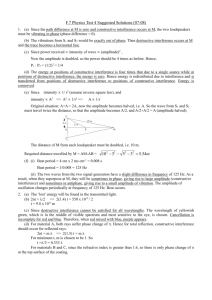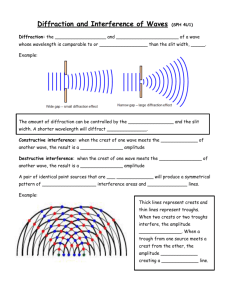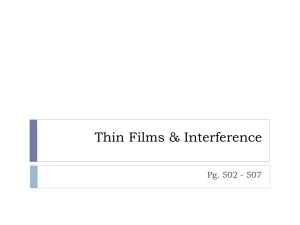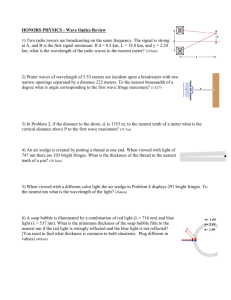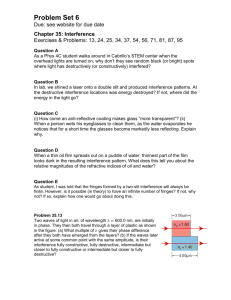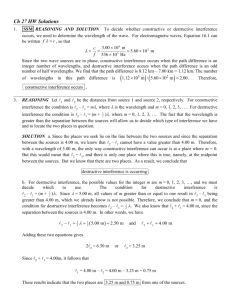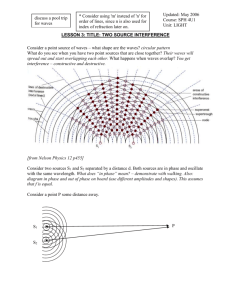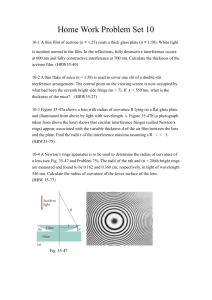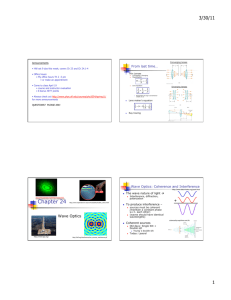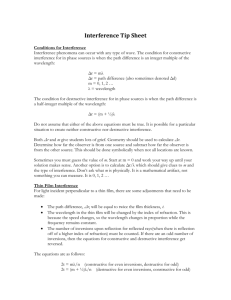Homework 11
advertisement
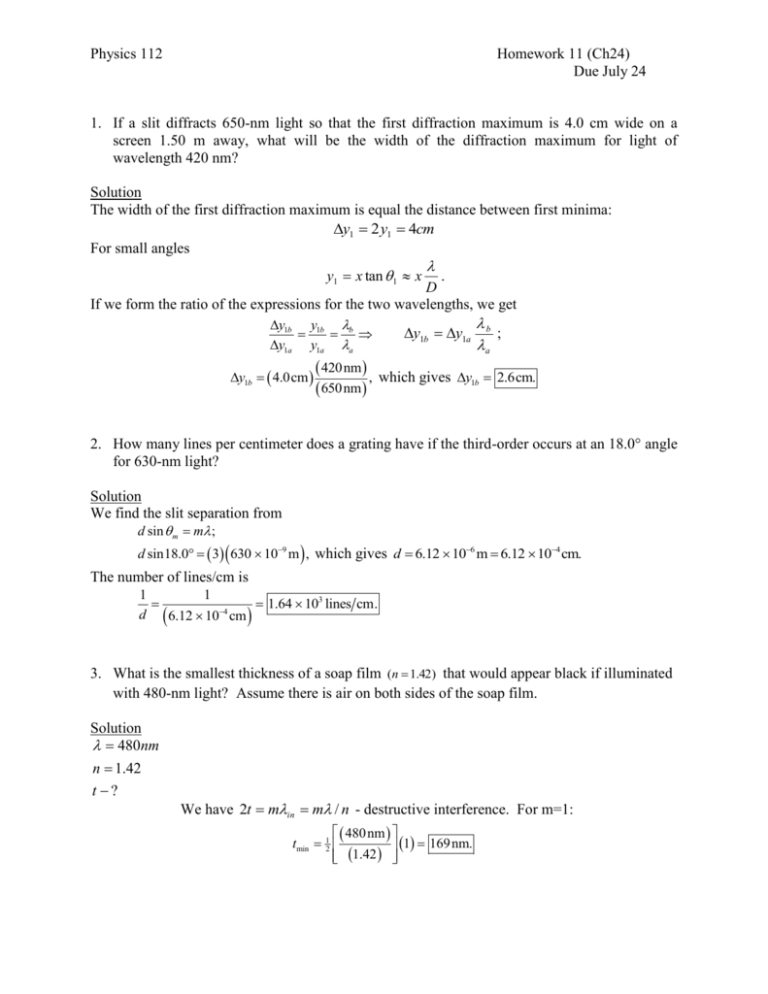
Physics 112 Homework 11 (Ch24) Due July 24 1. If a slit diffracts 650-nm light so that the first diffraction maximum is 4.0 cm wide on a screen 1.50 m away, what will be the width of the diffraction maximum for light of wavelength 420 nm? Solution The width of the first diffraction maximum is equal the distance between first minima: y1 2 y1 4cm For small angles y1 x tan 1 x . D If we form the ratio of the expressions for the two wavelengths, we get y1b y1b b y1b y1a b ; y1a y1a a a y1b 4.0cm 420nm , which gives 650nm y1b 2.6cm. 2. How many lines per centimeter does a grating have if the third-order occurs at an 18.0° angle for 630-nm light? Solution We find the slit separation from d sin m m ; d sin18.0 3 630 109 m , which gives d 6.12 106 m 6.12 104 cm. The number of lines/cm is 1 1 1.64 103 lines cm. d 6.12 104 cm 3. What is the smallest thickness of a soap film (n 1.42) that would appear black if illuminated with 480-nm light? Assume there is air on both sides of the soap film. Solution 480nm n 1.42 t ? We have 2t min m / n - destructive interference. For m=1: 480 nm tmin 12 1 169 nm. 1.42 Physics 112 Homework 11 (Ch24) Due July 24 4. How thick (minimum) should the air layer be between two flat glass surfaces if the glass is to appear bright when 450-nm light is incident normally? What if the glass is to appear dark? Solution 2t m 12 - constructive interference. The minimum non-zero thickness is (m=0) t min 14 450nm 113nm 2t m - destructive interference. The minimum non-zero thickness is (m=1) tmin 12 450nm1 225nm. 5. A thin film of alcohol (n 1.36) lies on a flat glass plate (n 1.51) . When monochromatic light, whose wavelength can be changed, is incident normally, the reflected light is a minimum for 512 nm and a maximum for 640 nm . What is the minimum thickness of the film? Solution Constructive interference: a 640 nm Destructive interference: b 512 nm a ,in a / n1 b,in b / n1 n1 1.36 The wave that reflects from the top surface of the alcohol has a phase change of , or 12 in terms of wave length. The wave that reflects from the glass at the bottom surface of the alcohol has a phase change of , or 12 in terms of wave length. for constructive interference 2t ma a / n1 for destructive interference 2t mb 12 b / n1 ma a / n1 mb 12 b / n1 , When we combine these two equations, we get: 2mb 1 a 640 5 or 2ma a b 512 4 Thus we see that ma mb 2 , and the thickness of the film is t ma a / 2n1 2 640nm / 2 1.36 471nm Because of that: Physics 112 Homework 11 (Ch24) Due July 24 6. What is Brewster’s angle for a diamond submerged in water if the light is hitting the diamond (n 2.42 ) while traveling in the water? Solution Because the light is coming from water to diamond, we find the angle from the vertical from n 2.42 tan p diamond 1.82, which gives p 61.2. nwater 1.33 7. Light of wavelength 590 nm passes through two narrow slits 0.60 mm apart. The screen is 1.70 m away. A second source of unknown wavelength produces its second-order fringe 1.33 mm closer to the central maximum than the 590-nm light. What is the wavelength of the unknown light? Solution For constructive interference, the path difference is a multiple of the wavelength: d sin m m , m 0, 1, 2, 3, ... . We find the location on the screen from: y x tan . For small angles: sin tan , which gives ym x m . d For the second-order fringes we have 2a 2 ; y2 b x b . d d When we subtract the two equations, we get yd 2x ; y ya yb 1 2 ; y 1 2x d 2 1.70m 590nm 2 , which gives 2 355nm. 1.33 103 m 3 0.60 10 m y2 a x 8. What is the minimum (non-zero) thickness for the air layer between two flat glass surfaces if the glass is to appear dark when 640-nm light is incident normally? What if the glass is to appear bright? The 12 - cycle phase change at the lower surface means the following 2t m , m 0, 1, 2, ... A) Destructive interference: 640nm We set m 1 to find the smallest nonzero value of t: t 320nm. 2 2 2t m 12 , m 0, 1, 2, ... B) Constructive interference: Solution: We set m 0 to find the smallest value of t: t 4 640nm 160nm. 4
